Impact of Artificial Intelligence on Business Competitive Advantage
VerifiedAdded on 2020/03/04
|8
|1569
|167
Project
AI Summary
This dissertation explores the impact of Artificial Intelligence (AI) on organizational competitive advantages. The research investigates how businesses leverage AI, focusing on machine learning and data analysis to gain insights and drive revenue. The study examines the challenges and opportunities associated with AI implementation, including financial constraints and workforce training. The research aims to evaluate AI's influence on competitive advantages, analyze associated challenges and opportunities, and recommend strategies for AI adoption. The methodology includes a descriptive research design, using both primary (interviews) and secondary data collection methods. The analysis will involve statistical tools to assess the impact of AI on business operations and competitiveness, with the potential outcome showing that organizations using AI have successfully derived competitive advantages. The dissertation also includes a discussion on research philosophy, approach, and ethical considerations, culminating in conclusions, recommendations, and suggestions for future research.

MSc – Management Strategy
Paraphrase This Document
Need a fresh take? Get an instant paraphrase of this document with our AI Paraphraser
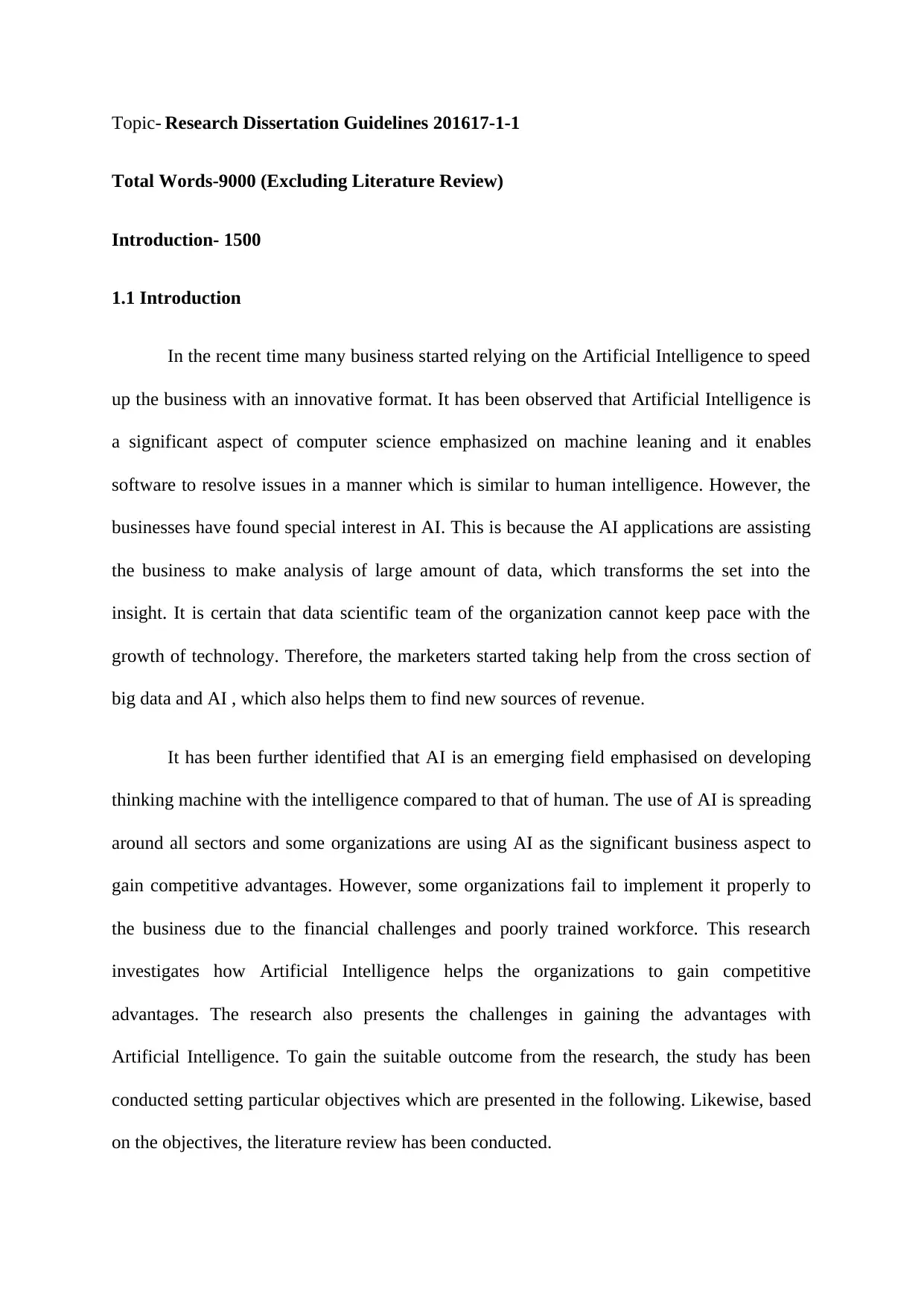
Topic- Research Dissertation Guidelines 201617-1-1
Total Words-9000 (Excluding Literature Review)
Introduction- 1500
1.1 Introduction
In the recent time many business started relying on the Artificial Intelligence to speed
up the business with an innovative format. It has been observed that Artificial Intelligence is
a significant aspect of computer science emphasized on machine leaning and it enables
software to resolve issues in a manner which is similar to human intelligence. However, the
businesses have found special interest in AI. This is because the AI applications are assisting
the business to make analysis of large amount of data, which transforms the set into the
insight. It is certain that data scientific team of the organization cannot keep pace with the
growth of technology. Therefore, the marketers started taking help from the cross section of
big data and AI , which also helps them to find new sources of revenue.
It has been further identified that AI is an emerging field emphasised on developing
thinking machine with the intelligence compared to that of human. The use of AI is spreading
around all sectors and some organizations are using AI as the significant business aspect to
gain competitive advantages. However, some organizations fail to implement it properly to
the business due to the financial challenges and poorly trained workforce. This research
investigates how Artificial Intelligence helps the organizations to gain competitive
advantages. The research also presents the challenges in gaining the advantages with
Artificial Intelligence. To gain the suitable outcome from the research, the study has been
conducted setting particular objectives which are presented in the following. Likewise, based
on the objectives, the literature review has been conducted.
Total Words-9000 (Excluding Literature Review)
Introduction- 1500
1.1 Introduction
In the recent time many business started relying on the Artificial Intelligence to speed
up the business with an innovative format. It has been observed that Artificial Intelligence is
a significant aspect of computer science emphasized on machine leaning and it enables
software to resolve issues in a manner which is similar to human intelligence. However, the
businesses have found special interest in AI. This is because the AI applications are assisting
the business to make analysis of large amount of data, which transforms the set into the
insight. It is certain that data scientific team of the organization cannot keep pace with the
growth of technology. Therefore, the marketers started taking help from the cross section of
big data and AI , which also helps them to find new sources of revenue.
It has been further identified that AI is an emerging field emphasised on developing
thinking machine with the intelligence compared to that of human. The use of AI is spreading
around all sectors and some organizations are using AI as the significant business aspect to
gain competitive advantages. However, some organizations fail to implement it properly to
the business due to the financial challenges and poorly trained workforce. This research
investigates how Artificial Intelligence helps the organizations to gain competitive
advantages. The research also presents the challenges in gaining the advantages with
Artificial Intelligence. To gain the suitable outcome from the research, the study has been
conducted setting particular objectives which are presented in the following. Likewise, based
on the objectives, the literature review has been conducted.
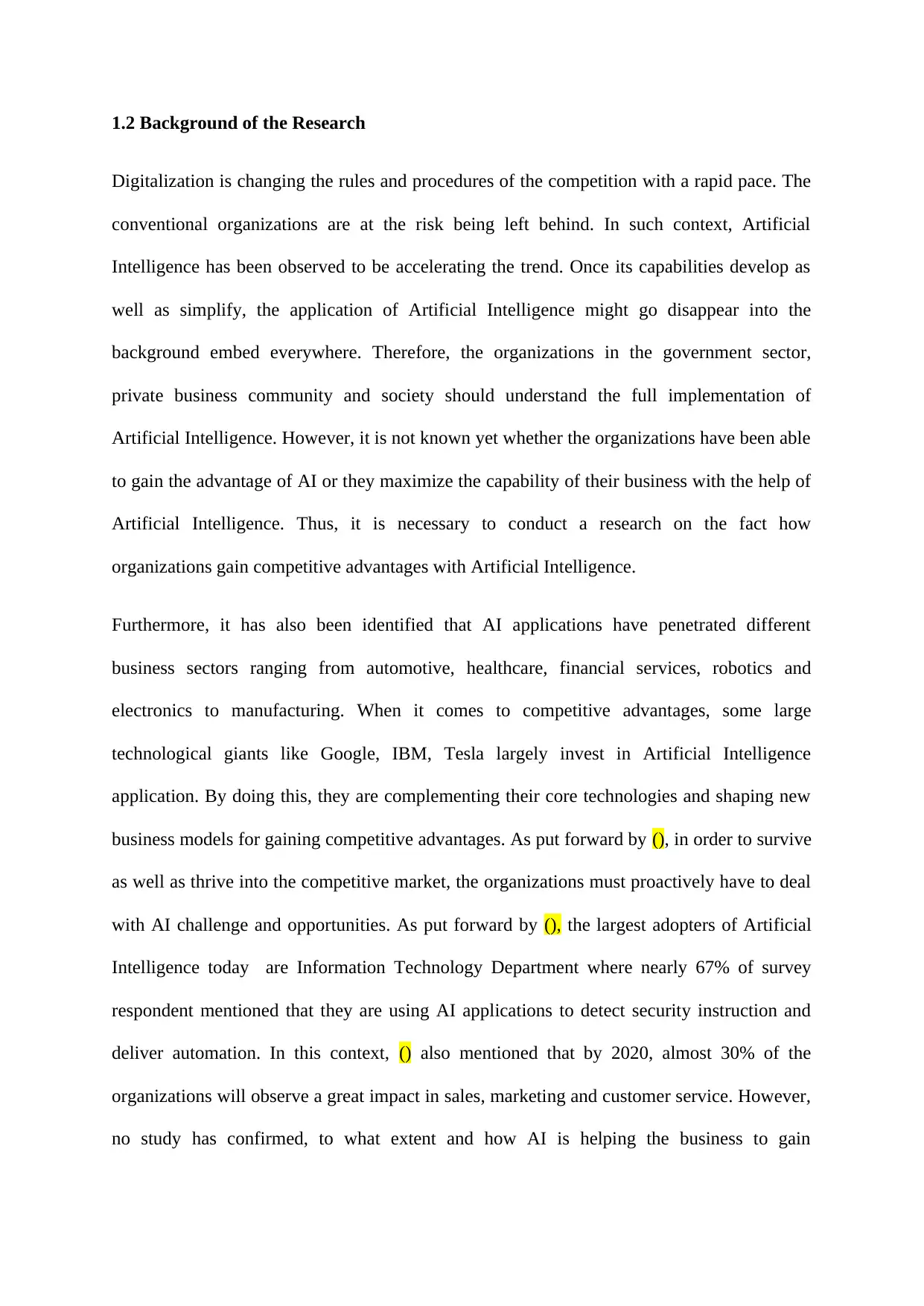
1.2 Background of the Research
Digitalization is changing the rules and procedures of the competition with a rapid pace. The
conventional organizations are at the risk being left behind. In such context, Artificial
Intelligence has been observed to be accelerating the trend. Once its capabilities develop as
well as simplify, the application of Artificial Intelligence might go disappear into the
background embed everywhere. Therefore, the organizations in the government sector,
private business community and society should understand the full implementation of
Artificial Intelligence. However, it is not known yet whether the organizations have been able
to gain the advantage of AI or they maximize the capability of their business with the help of
Artificial Intelligence. Thus, it is necessary to conduct a research on the fact how
organizations gain competitive advantages with Artificial Intelligence.
Furthermore, it has also been identified that AI applications have penetrated different
business sectors ranging from automotive, healthcare, financial services, robotics and
electronics to manufacturing. When it comes to competitive advantages, some large
technological giants like Google, IBM, Tesla largely invest in Artificial Intelligence
application. By doing this, they are complementing their core technologies and shaping new
business models for gaining competitive advantages. As put forward by (), in order to survive
as well as thrive into the competitive market, the organizations must proactively have to deal
with AI challenge and opportunities. As put forward by (), the largest adopters of Artificial
Intelligence today are Information Technology Department where nearly 67% of survey
respondent mentioned that they are using AI applications to detect security instruction and
deliver automation. In this context, () also mentioned that by 2020, almost 30% of the
organizations will observe a great impact in sales, marketing and customer service. However,
no study has confirmed, to what extent and how AI is helping the business to gain
Digitalization is changing the rules and procedures of the competition with a rapid pace. The
conventional organizations are at the risk being left behind. In such context, Artificial
Intelligence has been observed to be accelerating the trend. Once its capabilities develop as
well as simplify, the application of Artificial Intelligence might go disappear into the
background embed everywhere. Therefore, the organizations in the government sector,
private business community and society should understand the full implementation of
Artificial Intelligence. However, it is not known yet whether the organizations have been able
to gain the advantage of AI or they maximize the capability of their business with the help of
Artificial Intelligence. Thus, it is necessary to conduct a research on the fact how
organizations gain competitive advantages with Artificial Intelligence.
Furthermore, it has also been identified that AI applications have penetrated different
business sectors ranging from automotive, healthcare, financial services, robotics and
electronics to manufacturing. When it comes to competitive advantages, some large
technological giants like Google, IBM, Tesla largely invest in Artificial Intelligence
application. By doing this, they are complementing their core technologies and shaping new
business models for gaining competitive advantages. As put forward by (), in order to survive
as well as thrive into the competitive market, the organizations must proactively have to deal
with AI challenge and opportunities. As put forward by (), the largest adopters of Artificial
Intelligence today are Information Technology Department where nearly 67% of survey
respondent mentioned that they are using AI applications to detect security instruction and
deliver automation. In this context, () also mentioned that by 2020, almost 30% of the
organizations will observe a great impact in sales, marketing and customer service. However,
no study has confirmed, to what extent and how AI is helping the business to gain
⊘ This is a preview!⊘
Do you want full access?
Subscribe today to unlock all pages.

Trusted by 1+ million students worldwide
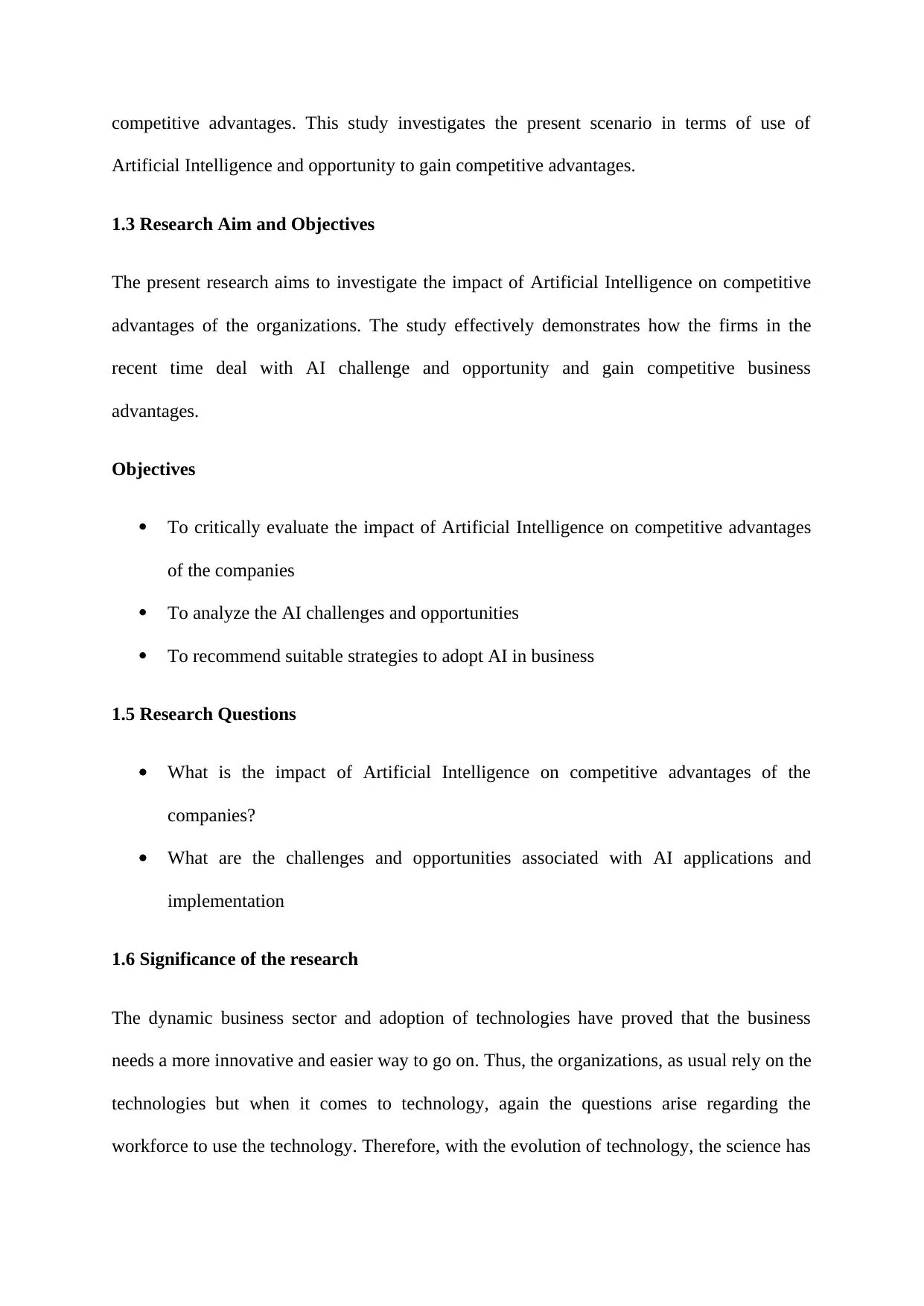
competitive advantages. This study investigates the present scenario in terms of use of
Artificial Intelligence and opportunity to gain competitive advantages.
1.3 Research Aim and Objectives
The present research aims to investigate the impact of Artificial Intelligence on competitive
advantages of the organizations. The study effectively demonstrates how the firms in the
recent time deal with AI challenge and opportunity and gain competitive business
advantages.
Objectives
To critically evaluate the impact of Artificial Intelligence on competitive advantages
of the companies
To analyze the AI challenges and opportunities
To recommend suitable strategies to adopt AI in business
1.5 Research Questions
What is the impact of Artificial Intelligence on competitive advantages of the
companies?
What are the challenges and opportunities associated with AI applications and
implementation
1.6 Significance of the research
The dynamic business sector and adoption of technologies have proved that the business
needs a more innovative and easier way to go on. Thus, the organizations, as usual rely on the
technologies but when it comes to technology, again the questions arise regarding the
workforce to use the technology. Therefore, with the evolution of technology, the science has
Artificial Intelligence and opportunity to gain competitive advantages.
1.3 Research Aim and Objectives
The present research aims to investigate the impact of Artificial Intelligence on competitive
advantages of the organizations. The study effectively demonstrates how the firms in the
recent time deal with AI challenge and opportunity and gain competitive business
advantages.
Objectives
To critically evaluate the impact of Artificial Intelligence on competitive advantages
of the companies
To analyze the AI challenges and opportunities
To recommend suitable strategies to adopt AI in business
1.5 Research Questions
What is the impact of Artificial Intelligence on competitive advantages of the
companies?
What are the challenges and opportunities associated with AI applications and
implementation
1.6 Significance of the research
The dynamic business sector and adoption of technologies have proved that the business
needs a more innovative and easier way to go on. Thus, the organizations, as usual rely on the
technologies but when it comes to technology, again the questions arise regarding the
workforce to use the technology. Therefore, with the evolution of technology, the science has
Paraphrase This Document
Need a fresh take? Get an instant paraphrase of this document with our AI Paraphraser
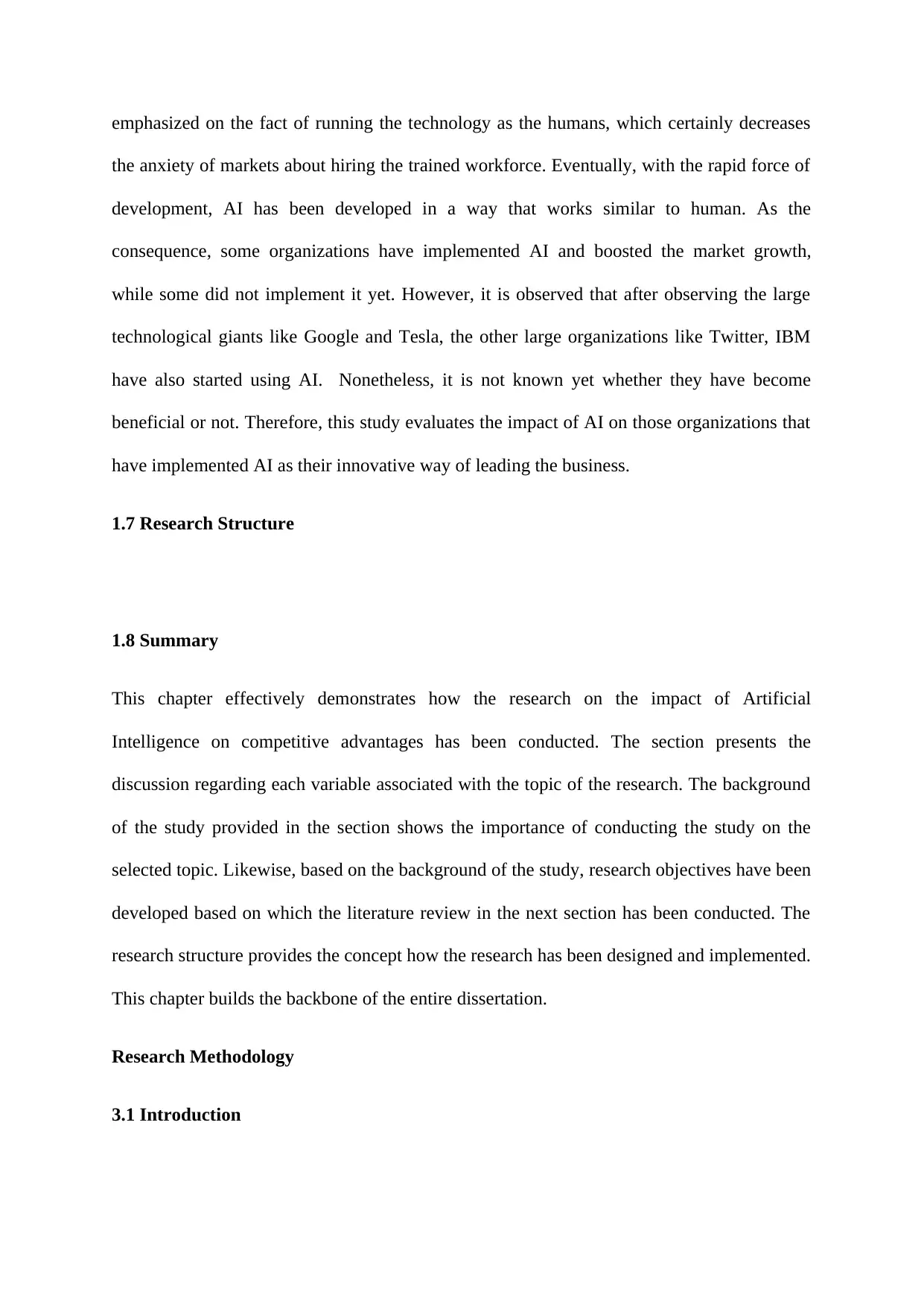
emphasized on the fact of running the technology as the humans, which certainly decreases
the anxiety of markets about hiring the trained workforce. Eventually, with the rapid force of
development, AI has been developed in a way that works similar to human. As the
consequence, some organizations have implemented AI and boosted the market growth,
while some did not implement it yet. However, it is observed that after observing the large
technological giants like Google and Tesla, the other large organizations like Twitter, IBM
have also started using AI. Nonetheless, it is not known yet whether they have become
beneficial or not. Therefore, this study evaluates the impact of AI on those organizations that
have implemented AI as their innovative way of leading the business.
1.7 Research Structure
1.8 Summary
This chapter effectively demonstrates how the research on the impact of Artificial
Intelligence on competitive advantages has been conducted. The section presents the
discussion regarding each variable associated with the topic of the research. The background
of the study provided in the section shows the importance of conducting the study on the
selected topic. Likewise, based on the background of the study, research objectives have been
developed based on which the literature review in the next section has been conducted. The
research structure provides the concept how the research has been designed and implemented.
This chapter builds the backbone of the entire dissertation.
Research Methodology
3.1 Introduction
the anxiety of markets about hiring the trained workforce. Eventually, with the rapid force of
development, AI has been developed in a way that works similar to human. As the
consequence, some organizations have implemented AI and boosted the market growth,
while some did not implement it yet. However, it is observed that after observing the large
technological giants like Google and Tesla, the other large organizations like Twitter, IBM
have also started using AI. Nonetheless, it is not known yet whether they have become
beneficial or not. Therefore, this study evaluates the impact of AI on those organizations that
have implemented AI as their innovative way of leading the business.
1.7 Research Structure
1.8 Summary
This chapter effectively demonstrates how the research on the impact of Artificial
Intelligence on competitive advantages has been conducted. The section presents the
discussion regarding each variable associated with the topic of the research. The background
of the study provided in the section shows the importance of conducting the study on the
selected topic. Likewise, based on the background of the study, research objectives have been
developed based on which the literature review in the next section has been conducted. The
research structure provides the concept how the research has been designed and implemented.
This chapter builds the backbone of the entire dissertation.
Research Methodology
3.1 Introduction
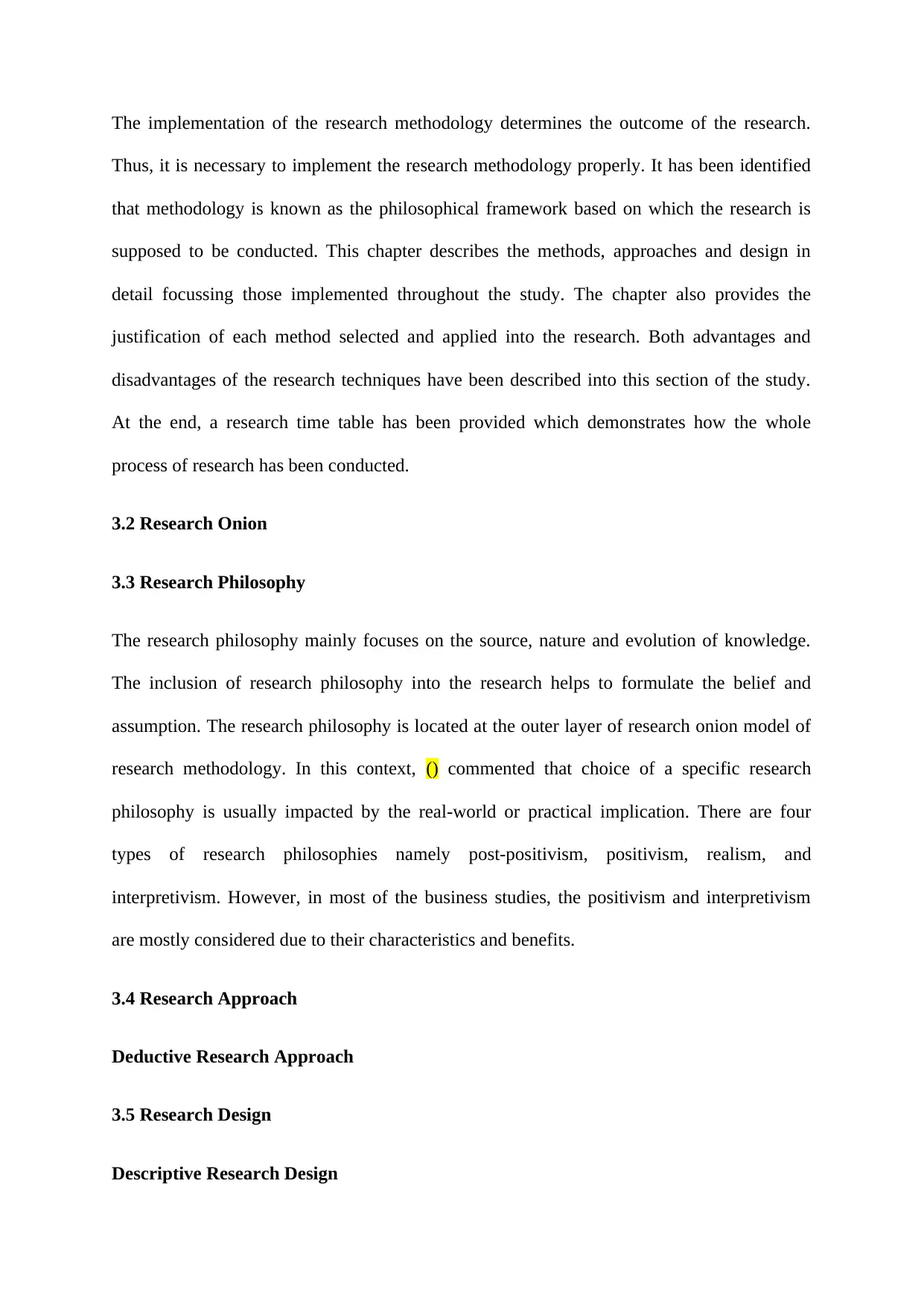
The implementation of the research methodology determines the outcome of the research.
Thus, it is necessary to implement the research methodology properly. It has been identified
that methodology is known as the philosophical framework based on which the research is
supposed to be conducted. This chapter describes the methods, approaches and design in
detail focussing those implemented throughout the study. The chapter also provides the
justification of each method selected and applied into the research. Both advantages and
disadvantages of the research techniques have been described into this section of the study.
At the end, a research time table has been provided which demonstrates how the whole
process of research has been conducted.
3.2 Research Onion
3.3 Research Philosophy
The research philosophy mainly focuses on the source, nature and evolution of knowledge.
The inclusion of research philosophy into the research helps to formulate the belief and
assumption. The research philosophy is located at the outer layer of research onion model of
research methodology. In this context, () commented that choice of a specific research
philosophy is usually impacted by the real-world or practical implication. There are four
types of research philosophies namely post-positivism, positivism, realism, and
interpretivism. However, in most of the business studies, the positivism and interpretivism
are mostly considered due to their characteristics and benefits.
3.4 Research Approach
Deductive Research Approach
3.5 Research Design
Descriptive Research Design
Thus, it is necessary to implement the research methodology properly. It has been identified
that methodology is known as the philosophical framework based on which the research is
supposed to be conducted. This chapter describes the methods, approaches and design in
detail focussing those implemented throughout the study. The chapter also provides the
justification of each method selected and applied into the research. Both advantages and
disadvantages of the research techniques have been described into this section of the study.
At the end, a research time table has been provided which demonstrates how the whole
process of research has been conducted.
3.2 Research Onion
3.3 Research Philosophy
The research philosophy mainly focuses on the source, nature and evolution of knowledge.
The inclusion of research philosophy into the research helps to formulate the belief and
assumption. The research philosophy is located at the outer layer of research onion model of
research methodology. In this context, () commented that choice of a specific research
philosophy is usually impacted by the real-world or practical implication. There are four
types of research philosophies namely post-positivism, positivism, realism, and
interpretivism. However, in most of the business studies, the positivism and interpretivism
are mostly considered due to their characteristics and benefits.
3.4 Research Approach
Deductive Research Approach
3.5 Research Design
Descriptive Research Design
⊘ This is a preview!⊘
Do you want full access?
Subscribe today to unlock all pages.

Trusted by 1+ million students worldwide
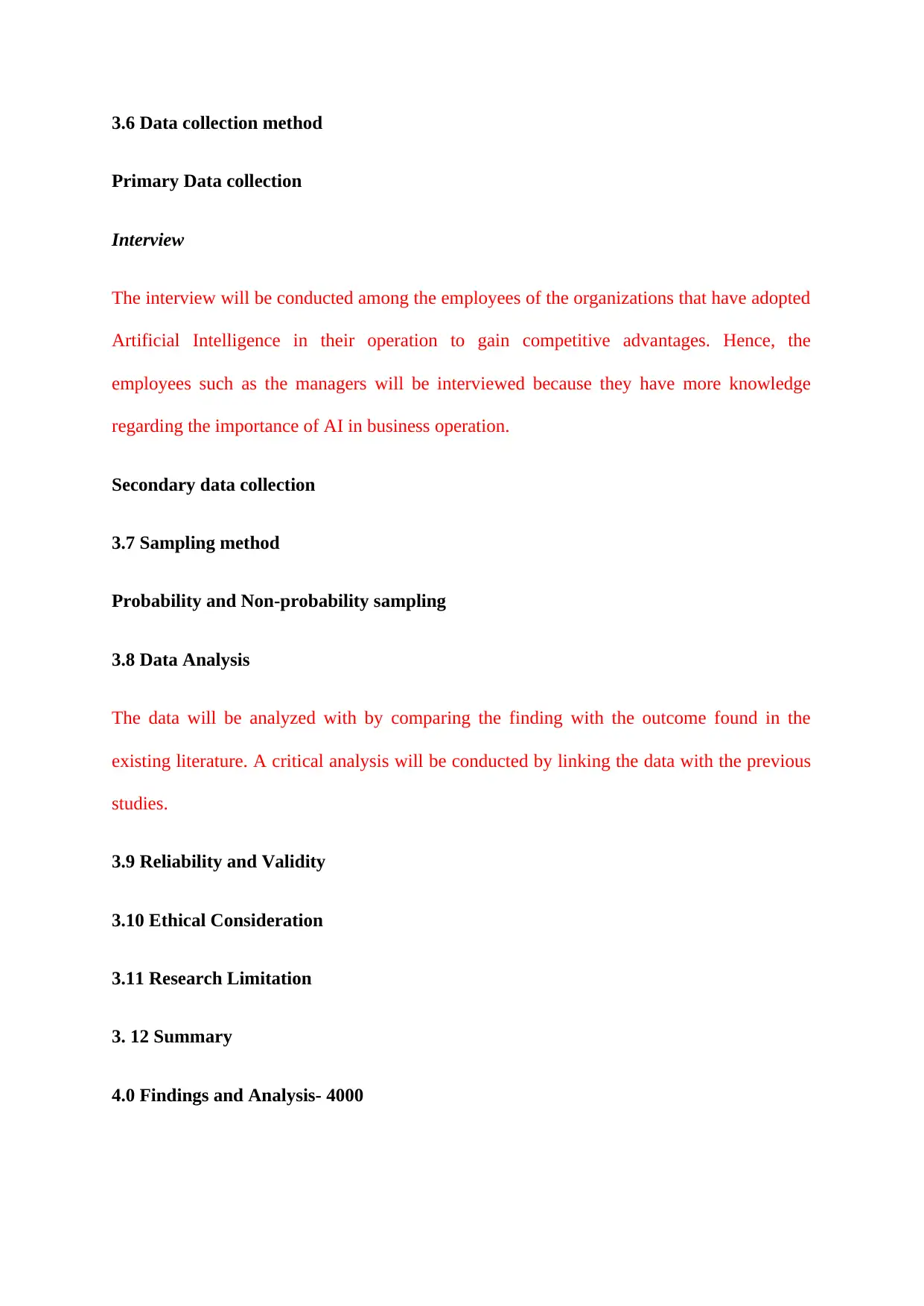
3.6 Data collection method
Primary Data collection
Interview
The interview will be conducted among the employees of the organizations that have adopted
Artificial Intelligence in their operation to gain competitive advantages. Hence, the
employees such as the managers will be interviewed because they have more knowledge
regarding the importance of AI in business operation.
Secondary data collection
3.7 Sampling method
Probability and Non-probability sampling
3.8 Data Analysis
The data will be analyzed with by comparing the finding with the outcome found in the
existing literature. A critical analysis will be conducted by linking the data with the previous
studies.
3.9 Reliability and Validity
3.10 Ethical Consideration
3.11 Research Limitation
3. 12 Summary
4.0 Findings and Analysis- 4000
Primary Data collection
Interview
The interview will be conducted among the employees of the organizations that have adopted
Artificial Intelligence in their operation to gain competitive advantages. Hence, the
employees such as the managers will be interviewed because they have more knowledge
regarding the importance of AI in business operation.
Secondary data collection
3.7 Sampling method
Probability and Non-probability sampling
3.8 Data Analysis
The data will be analyzed with by comparing the finding with the outcome found in the
existing literature. A critical analysis will be conducted by linking the data with the previous
studies.
3.9 Reliability and Validity
3.10 Ethical Consideration
3.11 Research Limitation
3. 12 Summary
4.0 Findings and Analysis- 4000
Paraphrase This Document
Need a fresh take? Get an instant paraphrase of this document with our AI Paraphraser
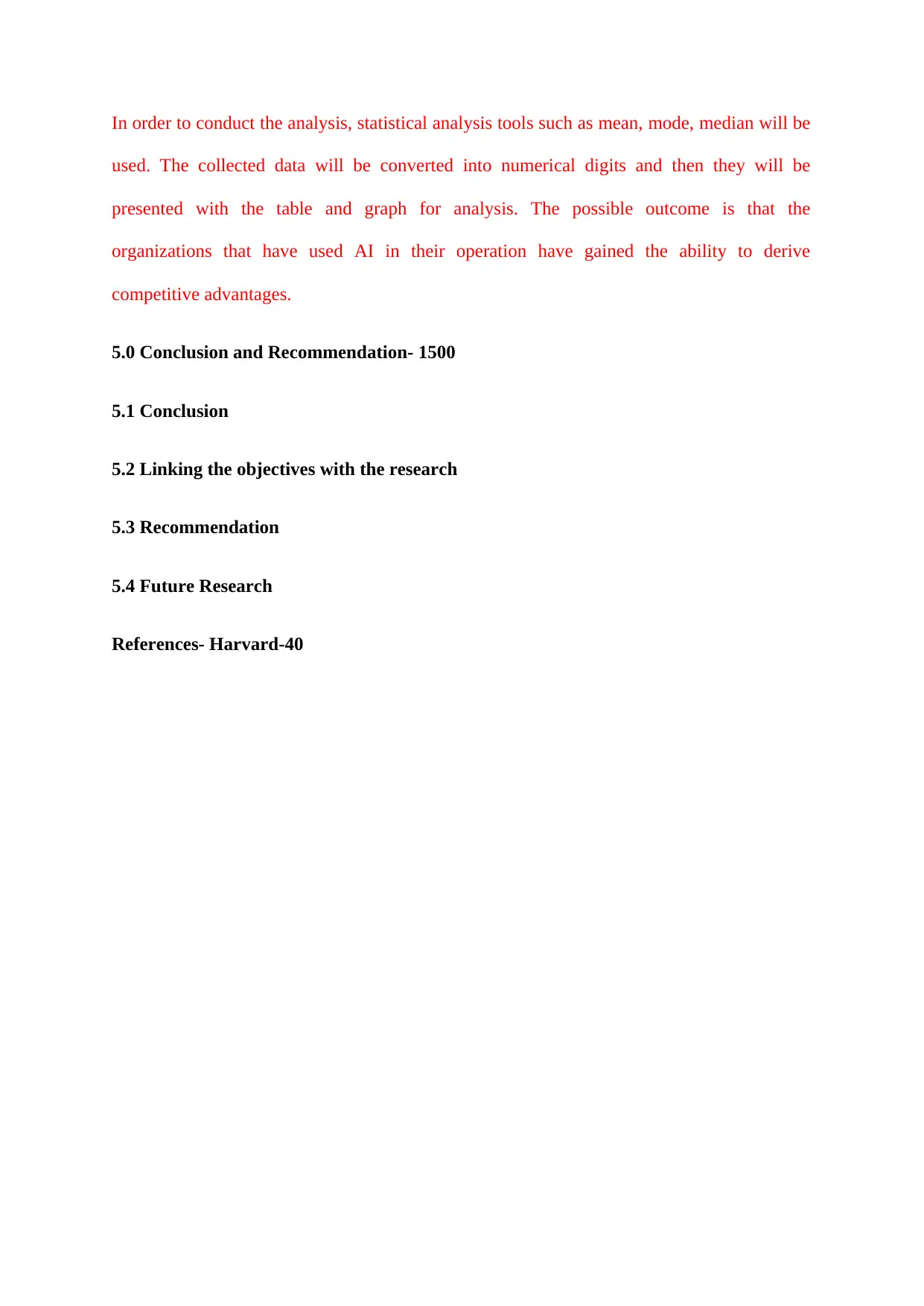
In order to conduct the analysis, statistical analysis tools such as mean, mode, median will be
used. The collected data will be converted into numerical digits and then they will be
presented with the table and graph for analysis. The possible outcome is that the
organizations that have used AI in their operation have gained the ability to derive
competitive advantages.
5.0 Conclusion and Recommendation- 1500
5.1 Conclusion
5.2 Linking the objectives with the research
5.3 Recommendation
5.4 Future Research
References- Harvard-40
used. The collected data will be converted into numerical digits and then they will be
presented with the table and graph for analysis. The possible outcome is that the
organizations that have used AI in their operation have gained the ability to derive
competitive advantages.
5.0 Conclusion and Recommendation- 1500
5.1 Conclusion
5.2 Linking the objectives with the research
5.3 Recommendation
5.4 Future Research
References- Harvard-40
1 out of 8
Related Documents
Your All-in-One AI-Powered Toolkit for Academic Success.
+13062052269
info@desklib.com
Available 24*7 on WhatsApp / Email
![[object Object]](/_next/static/media/star-bottom.7253800d.svg)
Unlock your academic potential
Copyright © 2020–2025 A2Z Services. All Rights Reserved. Developed and managed by ZUCOL.





